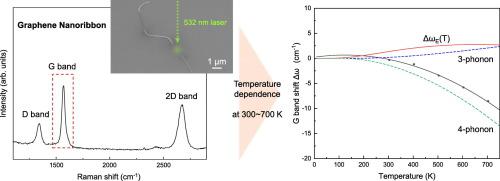当前位置:
X-MOL 学术
›
Diam. Relat. Mater.
›
论文详情
Our official English website, www.x-mol.net, welcomes your feedback! (Note: you will need to create a separate account there.)
Temperature dependence of the Raman spectra of multilayer graphene nanoribbons fabricated by unzipping method
Diamond and Related Materials ( IF 4.1 ) Pub Date : 2020-11-01 , DOI: 10.1016/j.diamond.2020.108047 Marina Tsujimoto , Makoto Tanimura , Masaru Tachibana
Diamond and Related Materials ( IF 4.1 ) Pub Date : 2020-11-01 , DOI: 10.1016/j.diamond.2020.108047 Marina Tsujimoto , Makoto Tanimura , Masaru Tachibana

|
Abstract The temperature dependence of Raman spectra of multilayer-graphene nanoribbons (MLGNRs) fabricated by unzipping method was investigated in the temperature range from 300 K to 700 K. MLGNRs with the width of ~200 nm are isolated and individually measured. The frequency of G band is monotonically downshifted with increasing temperature. The change in the G band frequency with temperature is reversible in thermal cycles with heating and cooling. By linear fitting, the temperature coefficient is estimated to be about −0.021 cm−1/K. This value is smaller than −0.028 cm−1/K of carbon nanotubes and larger than −0.011 and −0.016 cm−1/K of graphite and graphene, respectively, as reported previously. This means that MLGNRs are thermally stable compared with carbon nanotubes with curvatures, whereas the thermal stability of MLGNRs is lower than those of graphene and graphite. The better fitting to the G band frequency shift with temperature is obtained with nonlinear quadratic curve. From the theoretical analysis of the fitted quadratic curve, it is clarified that the downshift of G band frequency with increasing temperature is attributed to the anharmonic phonon interaction, especially 4-phonon process rather than 3-phonon process. Comparing with other nanocarbon materials reported so far, it is suggested that the strength of the anharmonic phonon interaction depends on the layer number and size of graphene.
中文翻译:

解压缩法制备的多层石墨烯纳米带的拉曼光谱的温度依赖性
摘要 在 300 K 至 700 K 的温度范围内研究了通过解压缩法制造的多层石墨烯纳米带 (MLGNRs) 的拉曼光谱的温度依赖性。将宽度为 ~200 nm 的 MLGNRs 隔离并单独测量。G 波段的频率随着温度的升高而单调下移。G 波段频率随温度的变化在加热和冷却的热循环中是可逆的。通过线性拟合,估计温度系数约为 -0.021 cm-1/K。如前所述,该值分别小于碳纳米管的 -0.028 cm-1/K 和大于石墨和石墨烯的 -0.011 和 -0.016 cm-1/K。这意味着与具有曲率的碳纳米管相比,MLGNR 具有热稳定性,而 MLGNRs 的热稳定性低于石墨烯和石墨。非线性二次曲线可以更好地拟合 G 波段频移随温度的变化。从拟合的二次曲线的理论分析可知,G波段频率随温度升高的下降归因于非谐声子相互作用,尤其是4声子过程而不是3声子过程。与目前报道的其他纳米碳材料相比,非谐声子相互作用的强度取决于石墨烯的层数和尺寸。阐明G带频率随温度升高的下降归因于非谐声子相互作用,尤其是4声子过程而不是3声子过程。与目前报道的其他纳米碳材料相比,非谐声子相互作用的强度取决于石墨烯的层数和尺寸。阐明G带频率随温度升高的下降归因于非谐声子相互作用,尤其是4声子过程而不是3声子过程。与目前报道的其他纳米碳材料相比,非谐声子相互作用的强度取决于石墨烯的层数和尺寸。
更新日期:2020-11-01
中文翻译:

解压缩法制备的多层石墨烯纳米带的拉曼光谱的温度依赖性
摘要 在 300 K 至 700 K 的温度范围内研究了通过解压缩法制造的多层石墨烯纳米带 (MLGNRs) 的拉曼光谱的温度依赖性。将宽度为 ~200 nm 的 MLGNRs 隔离并单独测量。G 波段的频率随着温度的升高而单调下移。G 波段频率随温度的变化在加热和冷却的热循环中是可逆的。通过线性拟合,估计温度系数约为 -0.021 cm-1/K。如前所述,该值分别小于碳纳米管的 -0.028 cm-1/K 和大于石墨和石墨烯的 -0.011 和 -0.016 cm-1/K。这意味着与具有曲率的碳纳米管相比,MLGNR 具有热稳定性,而 MLGNRs 的热稳定性低于石墨烯和石墨。非线性二次曲线可以更好地拟合 G 波段频移随温度的变化。从拟合的二次曲线的理论分析可知,G波段频率随温度升高的下降归因于非谐声子相互作用,尤其是4声子过程而不是3声子过程。与目前报道的其他纳米碳材料相比,非谐声子相互作用的强度取决于石墨烯的层数和尺寸。阐明G带频率随温度升高的下降归因于非谐声子相互作用,尤其是4声子过程而不是3声子过程。与目前报道的其他纳米碳材料相比,非谐声子相互作用的强度取决于石墨烯的层数和尺寸。阐明G带频率随温度升高的下降归因于非谐声子相互作用,尤其是4声子过程而不是3声子过程。与目前报道的其他纳米碳材料相比,非谐声子相互作用的强度取决于石墨烯的层数和尺寸。

























 京公网安备 11010802027423号
京公网安备 11010802027423号